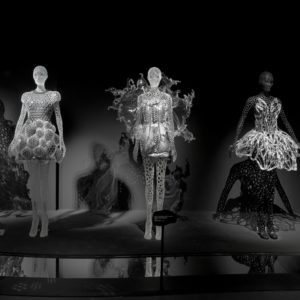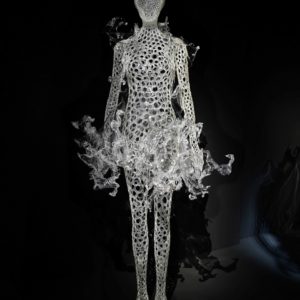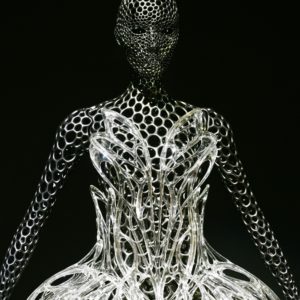Liquid Ghost Mannequins
Photopolymer Physique
Amsterdam, NL 2023
Philip Beesley Studio and Iris van Herpen created the new Liquid Ghost series of mannequins in order to accompany a series of couture creations mounted within the Water and Dreams exhibition gallery, located within the Musee des Arts Decoratifs 2023-24 Exhibition “Iris van Herpen: Sculpting the Senses”. The hovering characters of these figures have been carefully tuned by van Herpen and Beesley, evoking universal human forms. Each individual figure invites us to see new reflections of ourselves: are these wraith-beings the product of our own imagination?
Beesley and van Herpen worked with computational designers within the Beesley studio to develop custom algorithmic controls that are used to generate lace-like open webs of interconnected filamentary skeletons. Each cell is linked to its neighbour in interconnected webs of relationships. Innovative computer-controlled geometry underlies the expressive forms of these figures. Minute changes of balance and posture can be sculpted within this computational system, supporting vividly poised, graceful postures.
The technical form of each Liquid Ghost follows a non-regular tessellated geometry resulting in an organic distribution of polygons, emulating the close-packed cell arrays seen in nature. Like the colloidal filamentary structure of natural fascia, filaments converge at each junction, with varying angles that create a smooth surface curvature. Similar to constantly- shifting close-packed foams that appear within water, the filaments follow a meta-stable pattern where the proximity and arrangement of each segment within triangular and dual meshes inform the density of the cellular form. These cells vary in size and shape, creating a heterogeneous distribution across the structure.
While each Liquid Ghost is made with a minimum of material, its force-shedding lattice structure is based on optimal strength, creating a resilient membrane structure. The forms are fabricated using large-scale photopolymer 3d printing that employs pairs of focused lasers that trace and selectively harden minutely detailed components suspended within a resin bath.
Technical execution has been undertaken with Netherlands-based Hans Boodt and Fiberneering
PBSI
Philip Beesley
Timothy Boll
Kevan Cress
Jonathan Gotfryd
Lisa Jiang
Atelier IVH
Iris van Herpen
Christian Reiche
Hans Boodt
Coen Viguurs
Fiberneering
Martijn Buisman
Jasper Bouwmeester




